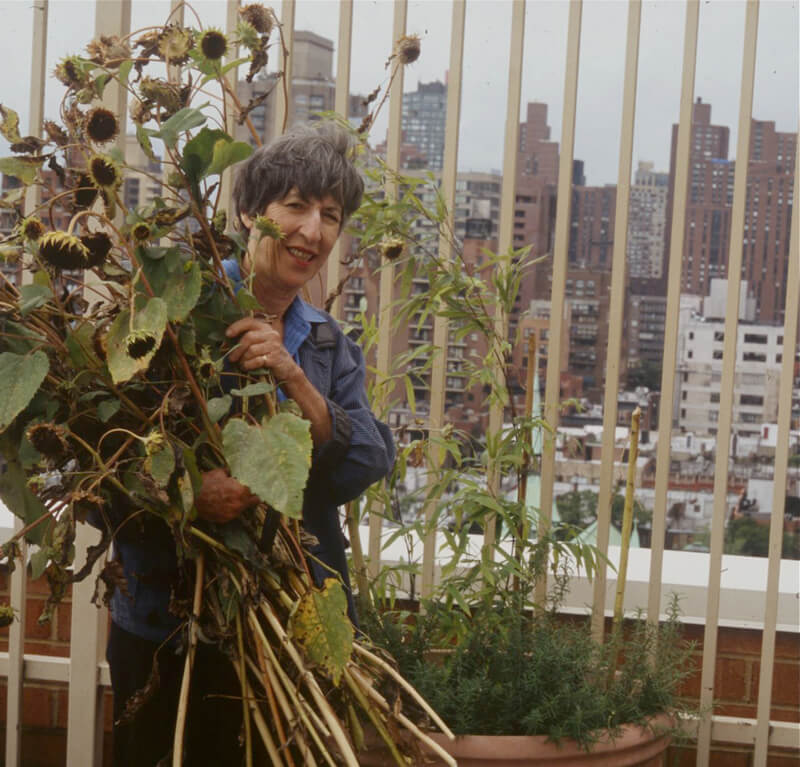When I gave up my 5-acre flower and herb farm in Pennsylvania and moved to Manhattan I was lucky to find a garden atop my condo building. I needed a garden. It needed a gardener. But what a different kind of garden it would be, complete with big-city challenges. The mixed-use roof measures 70 by 100 feet and houses garden containers, raised garden beds, furniture, and grills, along with room for children to play. People come up in the evening to read, sip wine, and dine. Teens hang out. It fits multiple needs.
One of my favorite parts of the garden is the herb section, where each year I plant sweet basil, cilantro, dill, fennel, borage, parsley, tarragon, rosemary, and perennial herbs for Zone 7 like chives, mint, lavender, sage, and lemon thyme. Residents who enjoy cooking can "pinch-an-inch" to add to most any recipe. It seems as if a few herb containers couldn't supply a whole building, but in a town where many people prefer restaurants or take-out, an inch is enough for those who know that 3 to 5 sprigs of fresh herbs can transform even the most mundane dish. Fresh mint for mojitos or mock-tails is essential.
Herbs (and all other plants) are organically grown here, so they need just a quick rinse to remove any dust before using. Sometimes kids riding trikes or playing hopscotch on the roof will pop a few mint leaves in their mouths, or chew on a few stems of chives without washing. A parent or nanny is always nearby to set the rules, and there seem to be no rinse rules on East 80th Street.
Gardening 18 floors above street level is different from every normal gardening situation I've been in from New Hampshire to California. There are challenges. If you live in a place where your only chance to garden is on a rooftop or balcony, I have a few suggestions.
Containers
Every plant must be in a container. There's no way to bring them indoors in winter, no place to store them. It's survival of the fittest, and everything else is an annual. Terra-cotta containers usually crack in hard frost conditions. I use a mix of cedar or teak boxes, good-looking plastic, high-fired stoneware clay, and fiberglass.
Soil
It's impossible to have yards of compost or a truckload of good topsoil delivered, so all soil is bought in bags and toted up to the roof on the elevator. I'm always running out of soil, as I can't seem to stop buying more containers and plants to feed my addiction. At last count, I had over 80 containers.
I prefer a lightweight potting soil, but since I don't run a car in the city, I'm usually stuck with whatever is available nearby from a very few choices. I don't buy bags with fertilizer premixed in the soil unless it's the rare occasion when I find an organic formulation.
Wind
The wind is unceasing. On sunny, hot days we call it a refreshing breeze. On cold days in the winter it's impossible to enjoy even a brief outing to the roof. But cold isn't the issue for the plants; wind dries the leaves, and if they are not watered at least once a day in the summer, plants will soon die.
I never protect any plant, summer or winter, from wind, cold, or sun. To paraphrase the song, if it can make it here, it can make it anywhere. On the other hand, if it can't make it here without extra effort, it must go.
Water
Gardeners in high-rises have great intentions to water once a day, but they don't! So, most professional gardeners that I know ask the apartment owner to install drip irrigation on any balcony, terrace, or penthouse. On my roof we have an outdoor water supply, a two-inch pipe that runs all the way around the perimeter of the garden, and 1 to 4 dripper lines to each container, depending on the size of the pot. The timer is set to open the valves twice a day. Of course, kids adore watering, so I often hand over a hose on hot days so they can "help me" in the garden.



Fertilizing / Compost
Most herbs don't need rich soil, but I like to add something to my containers at the start of the growing season. It was killing me to throw out garden waste in big plastic bags and pay to have them hauled away and then turn around and pay for bagged compost. I started a small composting experiment with 2 large containers that were already on hand and layered my kitchen scraps (no meat, dairy, bread, or fats) with discarded leaves and deadheaded flowers, watered them, and covered them with a plastic lid. I stirred every few days, and in 7 weeks I was rewarded with homemade compost. The following winter found me with a pound of red wiggler worms in a worm bin in my condo, feeding them assiduously with food scraps, and by spring I had glorious worm castings to add in half cupfuls to various outdoor pots.
My composting program was introduced very quietly so non-gardeners wouldn't worry about smell or vermin, but we had neither. No more improvisation needed. I bought a real composting barrel tumbler and will make enough compost for all my needs.
Rooftop gardening is at least as satisfying as gardening on my farm because of the challenges I must overcome and the uniqueness of creating a garden oasis in this noisy, messy metropolis. When a butterfly visits my rooftop, I'm overwhelmed by the challenges it faces as well.
Article written by Ellen Spector Platt, the author of Lavender: How to Grow and Use the Fragrant Herb.




 Herbs
Herbs
 Vegetables
Vegetables
 Fruit
Fruit
 Flowers
Flowers
 Succulents
Succulents

